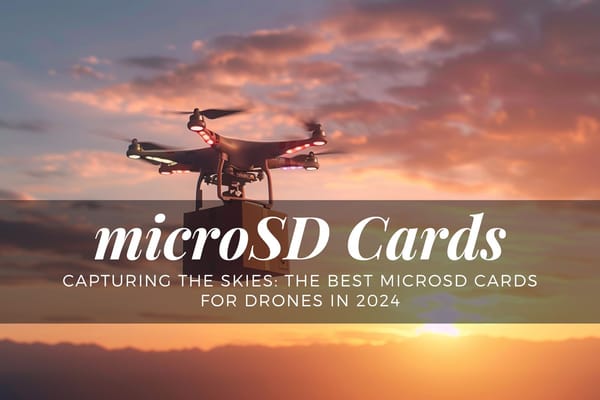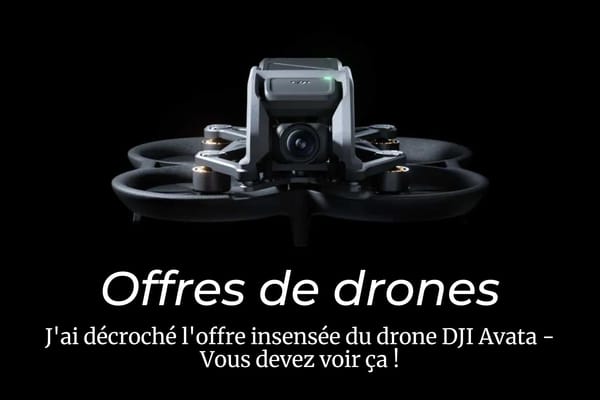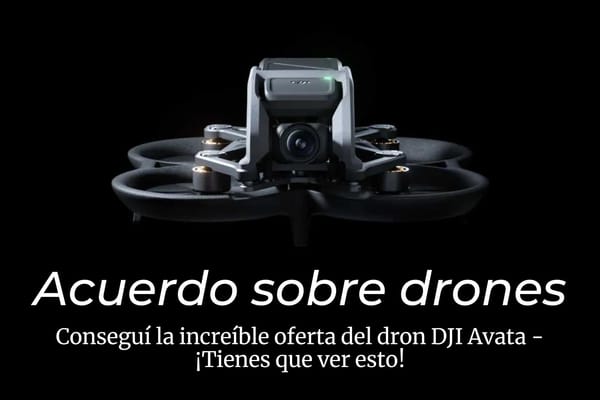Best MicroSD Card for Drones 2024

In the quest for the best MicroSD card for drones, my research has led me to some fascinating insights. The right card can significantly enhance your drone's performance, ensuring smooth, high-resolution video capture. Stay tuned as we delve into the world of speed, capacity, and price to find the perfect MicroSD card for your drone.
Key Takeaways
Best MicroSD Card for Drones
Best MicroSD Cards for DJI Mini 3
Best MicroSD Cards for DJI Mavic 3 (and Classic!)
Best MicroSD Cards for DJI Air 2S
- Choosing the Right Card: Selecting a high-quality MicroSD card with the appropriate speed class and capacity is crucial for capturing and securing high-resolution drone footage.
- Speed Class Matters: Look for at least a Class 10 or U3 rating when shooting 4K video to ensure minimum write speeds that keep up with your drone's camera.
- Compatibility Check: Verify that the MicroSD card is compatible with your specific drone model, particularly regarding capacity limits and speed requirements.
- Top Recommended Cards: The SanDisk Extreme UHS-I, Samsung Evo Plus, Lexar Professional 1000x, Kingston Canvas React, and PNY Elite Performance are among the best options for drone use.
- Maintenance is Key: Properly maintaining your MicroSD card by regular formatting and gentle handling can significantly extend its life and reliability.
- Troubleshooting: Knowing how to troubleshoot common issues like read/write errors and unrecognized cards can save the day and prevent data loss.
- Data Recovery: While data can sometimes be recovered from corrupted cards, regular backups are essential to avoid losing precious footage.
- Advanced Features: Advanced features like A1/A2 ratings for app performance on drones and the necessity of U3 for 4K video should not be overlooked by drone professionals.
By incorporating these takeaways, drone pilots can ensure they have the optimal setup for storing and safeguarding their aerial images and videos, allowing them to focus on capturing the best shots possible.
Introduction to MicroSD Cards for Drones
Drones have revolutionized photography and videography, offering a bird's-eye view that was once reserved for well-financed film productions. But capturing stunning aerial footage isn't just about the drone you fly; it's also about the storage on which you save your data. MicroSD cards play a critical role in your drone's ability to record high-quality images and videos. Choosing the right one is crucial for anyone looking to maximize the potential of their airborne endeavors.
Understanding the Importance of High-Quality MicroSD Cards for Drone Usage
When it comes to drones, not all MicroSD cards are created equal. The data transfer rate is a critical factor; a card too slow may not keep up with your drone's camera, leading to dropped frames or even lost footage. High-quality cards ensure quick write speeds, meaning your video and images save swiftly, keeping integrity intact.
Drones capture high-resolution and often high-frame-rate video, demanding speedy and reliable storage. An inadequate card can mean the difference between a flawless flight and a catastrophic footage failure. The card must handle the drone's maximum bitrate effortlessly, ensuring that breathtaking 4K footage remains crisp and stutter-free.
Evaluating MicroSD Card Specifications for Drone Pilots
Speed Class, UHS Speed Class, and Video Speed Class Ratings
These indicators tell you the minimum sustained writing speed of a card. Speed Class is denoted with a number inside a 'C' (e.g., Class 10), UHS Speed Class with a number inside a 'U' (e.g., U3), and Video Speed Class with a 'V' (e.g., V30). For drone cinematography, usually, a Class 10 or above is recommended.
Capacity: How Much Storage Do You Really Need?
This comes down to the resolution and duration of your flights. While a 32GB card may suffice for casual fliers, serious videographers will lean towards 64GB or even 128GB and beyond, ensuring they don't run out of space mid-flight.
Compatibility with Different Drone Models
Most drones support a range of MicroSD card sizes, but it's essential to check your drone's specifications. Some older or lower-end models may not support the larger capacities or the fastest speed classes.
Top 5 MicroSD Cards Recommended for Drones
1. SanDisk Extreme UHS-I
- This is a favorite among drone enthusiasts for its balance between cost and performance. With read speeds of up to 160MB/s and write speeds up to 90MB/s, it's a reliable choice for 4K UHD and Full HD video. Its durability against extreme conditions makes it ideal for adventurous drone pilots.
- Card offload speeds up to 190MB/s with SanDisk QuickFlow Technology.
- Maximum speeds achieved with SanDisk Professional PRO-READER SD and microSD (sold separately).
- Up to 130MB/s write speeds for fast shooting.
- 4K and 5K UHD-ready with UHS Speed Class 3 (U3) and Video Speed Class 30 (V30).
- Compatibility with microSDHC, microSDXC, microSDHC UHS-I, and microSDXC UHS-I supporting devices.
- Rated A2 for faster loading and in-app performance.
2. Samsung Evo Plus
- Noted for its robustness, the Evo Plus is fast with read/write speeds of up to 100MB/s and 90MB/s, respectively. It comes with a strong price-to-performance ratio, striking an excellent balance for those who want reliability without breaking the bank.
- Dependable Performance: EVO Plus offers enhanced speed and compatibility for reliable transfers.
- Fast and Smooth Operation: Superfast U3, Class 10 speeds up to 130MB/s ensure quick, smooth performance.
- Flexible Storage Options: Choose from 64GB to 512GB for the perfect capacity to store memories.
- Comprehensive Protection: EVO Plus is safeguarded against water, temperature, X-ray, magnet, drop, and wearout.
- 10-Year Warranty: Backed by a 10-year limited warranty, ensuring long-term reliability.
- Top Flash Memory Brand: Trusted performance and reliability from the world's No. 1 flash memory brand.
3. Lexar Professional 1000x
- Offering speeds suitable for quickly capturing high-quality images and lengthy 4K video without interruption. Its UHS-II technology sets it apart, catering to higher efficiency for expert pilots focusing on Ultra HD content.
- UHS-II tech enables 150MB/s read speed for rapid data transfer.
- Ideal for sports cams, tablets, and smartphones as premium memory.
- Tailored for swift capture of high-res images and extended 1080p, 3D, 4K videos.
- SD UHS-II adapter boosts file transfer speed, enhancing workflow efficiency.
- Limited lifetime support for the card, one-year for the adapter included.
4. Kingston Canvas React
- A great card for videographers, this MicroSD leverages UHS-I U3 speeds to ensure consistent capture of crucial moments. It's been crafted with the needs of aerial photographers in mind, giving peace of mind when storing priceless views.
5. PNY Elite Performance
- If you're flying with budget constraints but don’t want to compromise on performance, this is your card. With impressive speed and capacity options, it delivers a solid performance punch for a wallet-friendly price.
In conclusion, the MicroSD card you choose for your drone can have a substantial impact on your flying and filming experience. Always ensure that your card meets at least the minimum speed classification recommended by your drone manufacturer and offers enough capacity to capture your envisioned content. By selecting the right card, you can focus on flying, safe in the knowledge that your aerial footage will be recorded seamlessly and securely. Stay tuned for Part 2, where we’ll delve into advanced considerations and usage tips for drone enthusiasts.
Advanced Considerations and Usage Tips
Beyond the basics of speed class and capacity, there are several advanced features and best practices to consider when selecting and using MicroSD cards for your drone. Ensuring that your card is up to the task will help you capture truly stunning aerial footage without any hiccups.
Advanced Features of MicroSD Cards for Drones
A1/A2 Ratings for App Performance
The A1 and A2 ratings refer to the card's ability to run and store apps efficiently, a feature more relevant to smartphones. However, for drones that use apps for in-flight features or additional processing power, an A-rated card can improve overall performance.
The Importance of U3 for 4K Video Capture
If you're shooting in 4K, the U3 rating is vital, as it ensures a minimum write speed of 30MB/s, capable of handling the high data rates required by 4K video. This will prevent dropped frames and ensure maximum clarity of your drone's footage.
How to Protect and Maintain Your MicroSD Cards
Best Practices for Data Integrity and Card Health
- Regularly format your card in the drone itself, not on a computer, to keep the file system uncorrupted and ensure maximum compatibility.
- Avoid filling the card to capacity, as this may slow down write speeds. Keep a buffer of at least a few gigabytes free.
- Power down your drone before removing the card to prevent data loss or corruption.
- Handle the card carefully, avoiding contact with the metal connectors.
Tips on Safe Ejection and Storage of MicroSD Cards
- Eject the card gently to minimize the risk of damaging the delicate pins.
- Store your MicroSD cards in a protective case when not in use to keep them safe from physical damage and electromagnetic exposure.
- Always keep spare cards on hand in case of failure or loss. This ensures you're prepared for every filming opportunity.
Troubleshooting Common MicroSD Card Issues in Drones
Resolving Read/Write Errors
- Ensure your MicroSD card is not locked in the "Read-only" position.
- Use your drone's formatting function or a reputable computer application to format the card, resolving potential file system issues.
- Check for firmware updates for your drone, which may address compatibility issues with certain MicroSD cards.
What to Do if Your Drone Doesn't Recognize the MicroSD Card
- First, ensure that the card is correctly inserted and fully seated in the slot.
- Try a different card to determine if the issue is card-specific or a possible drone malfunction.
- Clean the card's metal contacts gently with a soft, dry cloth to ensure proper connection.
FAQs About MicroSD Cards for Drones
How Do I Know if a MicroSD Card is Compatible with My Drone?
Review your drone's manual for the recommended speed class and maximum capacity. Manufacturers will list the preferred specs for optimal performance.
What's the Difference Between Writing Speed and Reading Speed, and Why Does It Matter?
Writing speed is crucial for recording data, while reading speed affects how fast you can download or view content. For drones, writing speed is more critical as it ensures that your high-definition video gets saved without errors.
How Frequently Should I Format My Drone's MicroSD Card?
It varies, but a good rule of thumb is to format the card after every few sessions of heavy use. This can prevent corruption and maintain the card’s health over time.
Can I Recover Data from a Corrupted MicroSD Card Used in a Drone?
Sometimes, yes. There are data recovery tools available that can sometimes restore lost files, but it’s not guaranteed. Always back up your footage regularly to avoid this danger.
Conclusion
Selecting the perfect MicroSD card for your drone is about more than just capacity and cost—it's about reliable, high-performance storage that meets the demands of your device. It's also about maintaining your cards properly to ensure they're ready when you need them and know how to troubleshoot issues when they arise. By using the knowledge and tips provided here, you will be able to capture stunning, high-quality drone footage with confidence, knowing that your memories are stored safely on a reliable MicroSD card.
Remember, your stories are as lofty as the skies you explore, and with the right MicroSD card, you are free to capture them in all their glory. Enjoy your flight!


